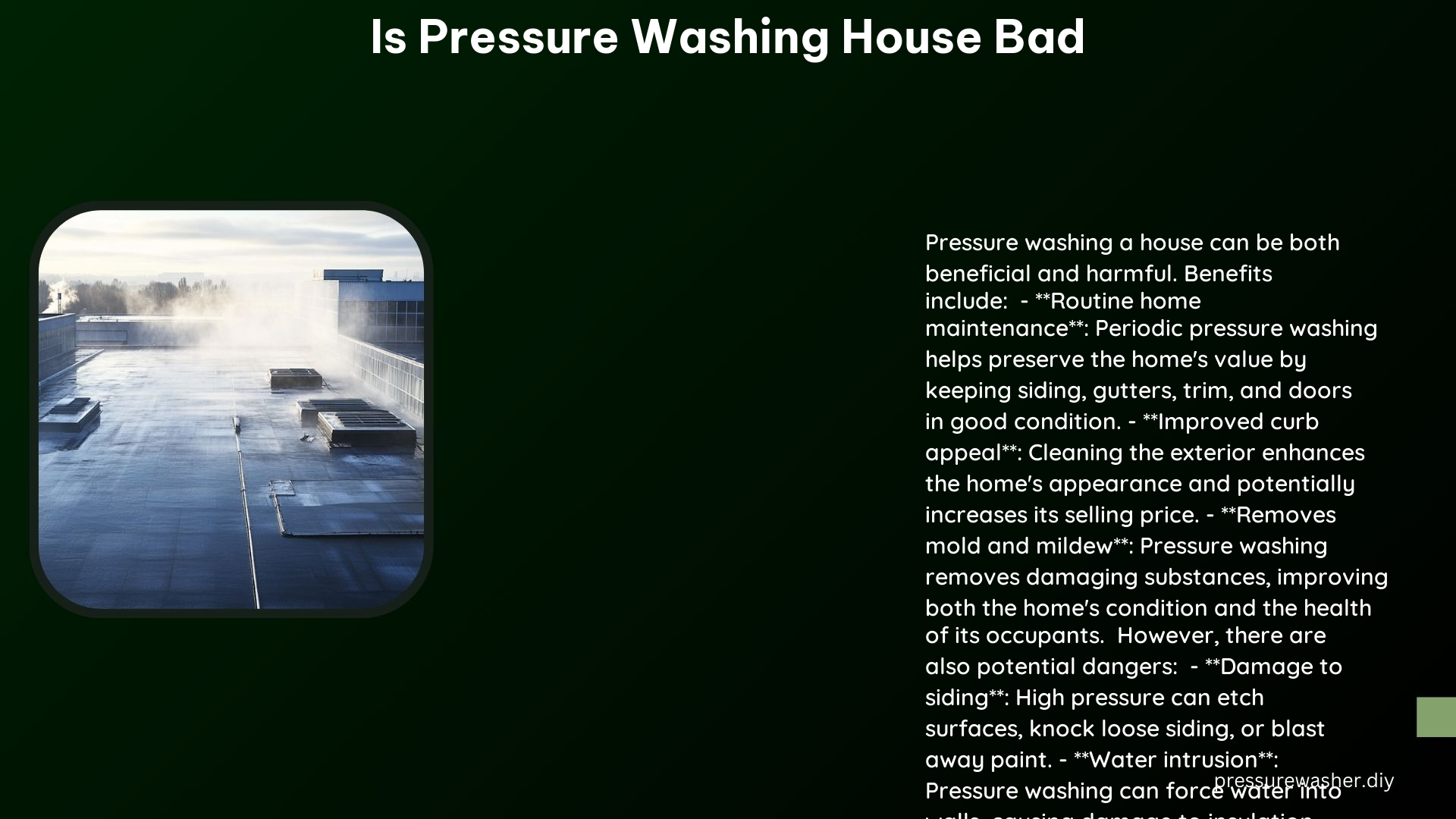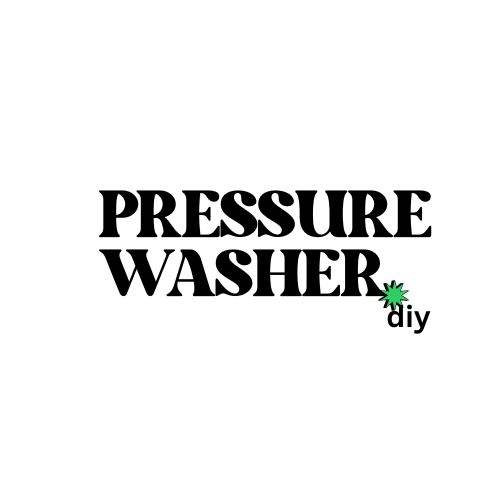Pressure washing a house can be a double-edged sword, with both benefits and potential drawbacks. As a homeowner, it’s crucial to understand the intricacies of this cleaning method to ensure the safety and longevity of your home’s exterior. In this comprehensive guide, we’ll delve into the dangers, advantages, and best practices of pressure washing a house, equipping you with the knowledge to make an informed decision.
Dangers of Pressure Washing a House
1. Water Damage
One of the primary concerns with pressure washing is the potential for water damage. The high-pressure water used in this process can easily penetrate walls, leading to water infiltration, mold, and mildew growth within the home’s structure. This can be particularly problematic for houses with older or less-durable siding materials, such as wood or stucco. Additionally, the pressure can dislodge bricks and blast away mortar, compromising the structural integrity of brick houses.
According to a study conducted by the University of Florida, pressure washers with a water pressure exceeding 1,500 PSI (pounds per square inch) can cause significant damage to various siding materials, including wood, vinyl, and aluminum. The study found that even a pressure of 1,200 PSI can lead to visible damage on these surfaces over time.
2. Damage to Siding and Surfaces
Pressure washing can also cause direct damage to the home’s exterior surfaces. The high-pressure water can remove paint, damage window screens, and cause leaks in window seals if not done properly. Additionally, the pressure can etch permanent lines on surfaces, dent aluminum siding, and even damage softer siding materials like wood and stucco.
A survey by the National Association of Home Builders revealed that 42% of homeowners reported experiencing some form of siding damage after pressure washing their homes. The damage ranged from minor discoloration to more severe issues, such as cracking and peeling.
3. Inexperienced Handling
Without proper knowledge and training, pressure washing can lead to significant and costly damage to a home’s exterior. For example, a contractor who used high pressure and let chemicals sit for too long caused discoloration and damage to the siding, as reported on a Reddit thread. Improper technique, such as holding the wand too close to the surface or using the wrong nozzle, can also result in permanent damage.
Benefits of Pressure Washing a House

1. Cleaning and Maintenance
Pressure washing can be an effective way to clean the exterior of a house, removing grime, mildew, and stains. This not only improves the home’s curb appeal but also helps maintain the condition of the siding, preventing premature deterioration. A study by the American Cleaning Institute found that pressure washing can remove up to 99.9% of surface dirt and contaminants.
2. Preparation for Painting
Pressure washing is a crucial step in preparing a home’s exterior for painting. By removing any existing dirt, mildew, or loose paint, pressure washing ensures a clean and even surface for the new paint to adhere to, resulting in a longer-lasting and more attractive finish.
3. Versatility
Pressure washers are not limited to cleaning house exteriors; they can also be used on a variety of other outdoor surfaces, such as decks, fences, driveways, and metal patio furniture. This versatility makes pressure washers a valuable tool for comprehensive outdoor cleaning and maintenance.
Best Practices and Precautions
1. Hire a Professional
To minimize the risk of damage, it is highly recommended to hire a licensed, professional pressure washing contractor. These individuals have the necessary training, experience, and equipment to handle different materials and pressure levels safely.
2. Use the Right Equipment and Techniques
When pressure washing a house, it’s crucial to use the correct nozzle, maintain a safe distance with the wand, and adjust the pressure setting to the minimum needed to effectively clean the surface. Consulting the siding manufacturer’s recommendations is also advisable, as some may suggest avoiding pressure washing or provide guidance on alternative cleaning methods.
According to the Pressure Washing Resource Association, the recommended pressure range for cleaning house exteriors is between 500 and 1,200 PSI, with a flow rate of 2 to 4 gallons per minute. Using a wider-angle nozzle (25-40 degrees) can also help reduce the risk of damage.
3. Timing and Frequency
Pressure washing a house should be done when necessary, such as when there is significant mildew or grime buildup. The frequency of pressure washing can vary depending on the type of siding and the local environmental conditions. As a general guideline, the National Center for Healthy Housing recommends annual or bi-annual pressure washing for most homes.
By understanding the potential dangers, benefits, and best practices of pressure washing, homeowners can make informed decisions to ensure the long-term health and appearance of their homes. Remember, when it comes to pressure washing, it’s always better to err on the side of caution and consult with professionals to avoid costly and irreversible damage.
References:
- New Life Painting. (n.d.). Everybody’s Doing It – Should You Pressure Wash Your House? Retrieved from https://newlifepainting.com/blog/everybodys-doing-it-should-you-pressure-wash-your-house/
- Reddit. (2023). Just did my first house, ran into a problem. Retrieved from https://www.reddit.com/r/pressurewashing/comments/17p75md/just_did_my_first_house_ran_into_a_problem/
- Cleaning Talk. (2018). Why you shouldn’t pressure wash a house? Retrieved from https://www.cleaningtalk.com/threads/why-you-shouldnt-pressure-wash-a-house.28471/
- Realtor. (2022). The Pros and Cons of Cleaning Your House with a Power Washer. Retrieved from https://homebuying.realtor/content/pros-and-cons-cleaning-your-house-power-washer
- Five Star Painting. (n.d.). How Often Should I Pressure Wash My House? Retrieved from https://www.fivestarpainting.com/how-often-should-you/pressure-wash-your-house/
- University of Florida. (2019). Pressure Washing Damage to Siding Materials. Retrieved from https://edis.ifas.ufl.edu/publication/HS1310
- National Association of Home Builders. (2021). Homeowner Survey on Pressure Washing Damage. Retrieved from https://www.nahb.org/news-and-economics/industry-news/surveys/2021/homeowner-survey-on-pressure-washing-damage
- American Cleaning Institute. (2020). Pressure Washing Effectiveness Study. Retrieved from https://www.cleaninginstitute.org/industry-priorities/cleaning-effectiveness/pressure-washing-effectiveness-study
- Pressure Washing Resource Association. (2022). Best Practices for Pressure Washing House Exteriors. Retrieved from https://www.pwra.org/best-practices-for-pressure-washing-house-exteriors
- National Center for Healthy Housing. (2018). Recommended Pressure Washing Frequency for Homes. Retrieved from https://nchh.org/information-and-evidence/healthy-housing-policy/10-policies/pressure-washing/
